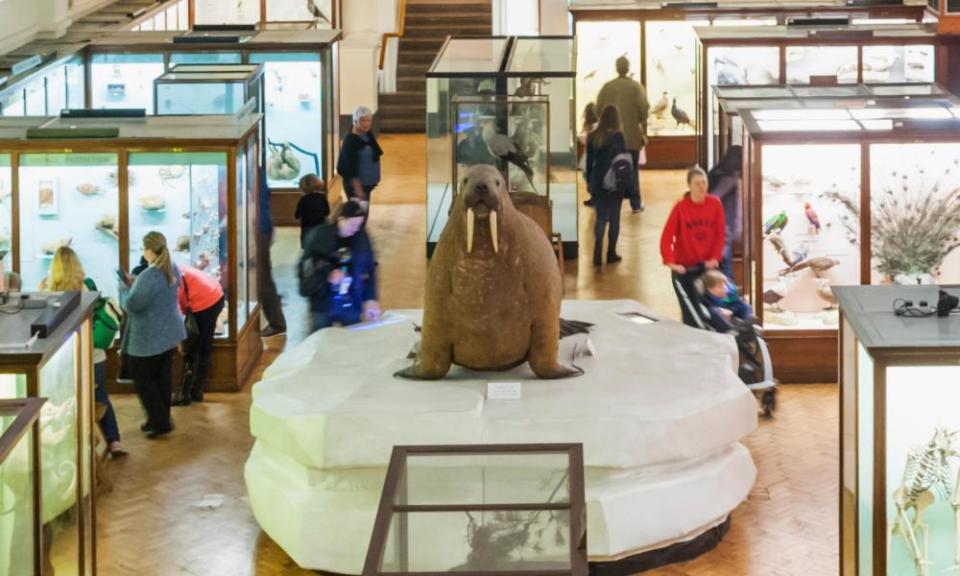Poem of the week: Please Do Not Touch the Walrus … by Caleb Parkin

A museum’s warning notice provides a gleeful invitation to transgress
Please Do Not Touch the Walrus or Sit on the Iceberg
Horniman Museum, Summer 2019
So, I clamber up, on top of the fibreglass plinth,
rise from the chevrons of the parquet floor
as though it melted into thick-cold waves
and I emerge, triumphant and substantial,
hear my epic belly boom on the fake ice,
hands slapping flatly on the hollow berg,
relaunch my fingers as weighty webbed
fins before I tackle his avuncular mass,
high-five his suedey and ample rump.
Together on our tiny island, I offer my new
form to brisk expanses, the gritty battlegrounds
of arctic beaches. My chest proud and lifted
as a dormant volcano. Then my incisors extend,
telescopic – tusks prodding at my clavicle bones.
Whiskers, these exhilarating bristles of whisker,
tickle out from the prow of my titanic mass.
We are in tandem, a double-breasted catamaran.
We are Rose and Jack on our own luxury boat.
And when staff approach with their lanyard spears,
their hunters’ walkie-talkies, to stare up at the hull
of our little world, our Oscar-nominated forever,
I’ll look down through blubbering eyes and briny
breathlessness, then whisper in impeccable walrus:
I’m flying.
Caleb Parkin’s impressive first collection, This Fruiting Body, is described on the jacket as “a playful invitation to a queer ecopoetics that permeates our bodies and speech, our gardens, homes and city suburbs”. Parkin’s playfulness of style is aligned with, but not weighed down by, a serious concern with crossing boundaries and challenging received pieties. Interviewed about his role as Bristol City Poet he remarks on the importance of acknowledging that ecology includes “all the icky stuff” – and the menagerie in This Fruiting Body faithfully investigates spiders, black mould and even a fatberg. This week’s poem focuses on a more conventional species, the walrus, but illustrates Parkin’s balance of wit, passion and humour. Since I remember the walrus in question from long-ago childhood visits to the Horniman Museum, I was delighted to meet him again and witness his apotheosis.
For the poem’s narrator, the rules about the exhibit set out in the title are calls to transgression. At first, we might imagine that narrator to be the walrus himself. But the third stanza makes it clear that it’s the human who has climbed the fake iceberg plinth and begun his own metamorphosis to walrus. Now he must “relaunch” his fingers as “weighty webbed fins” before going on to “tackle” the museum walrus, and “high-five his suedey and ample rump”. The pair are soon united on their “tiny island” and the speaker, still concerned with adding more intensely realised physical detail to his animal-self, extends his imagination now to include his surroundings, “the gritty battlegrounds / of arctic beaches”.
As if inspired by the iceberg, and launched by the phrases “epic belly” and “titanic mass”, the poem, as it evolves into a love story, finds an unexpected analogy with the encounter in the movie Titanic, where Rose and Jack harmonise ecstatically “in tandem” at the rail of the speeding ship. “I’m flying” are Rose’s words as she stands spread-armed on the ship’s railing.
Parkin’s method combines comedy and dignity. The film reference isn’t used to ridicule the creatures in the poem. Instead, the walrus romance seems to work satirically against the melodramatic movie romance: perhaps it also gently targets the overweening human ambition for making epic movies and building unsinkable ships. The poem’s fantasy, also movie-like, lets love triumph over rules and boundaries, but not without likely retribution, as the museum staff approach with their “lanyard spears” and “hunters’ walkie-talkies”. While the narrator has the last words, the “blubbering eyes” might suggest there is only a seized moment of glory and no happy “forever” for this Rose and Jack.
We could read the poem as a lightly carried warning about environmentalism as “epic” utopian fantasy. What matters most, though, is the way it brings us so close to the walrus we begin to inhabit its body and feel its sensations. At the poem’s heart there is a real live animal (or two) with fins, tusks and whiskers, celebrated but not romanticised, not (unlike the iceberg) fake.

